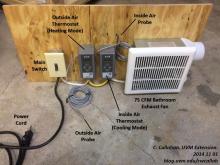In colder climates winter storage crops have been stored in passive root cellars for centuries. Although modern refrigeration systems are generally used for large scale, longer-term storage of these crops some enterprises seek lower cost and high energy efficiency options. Outside air exchange systems use an exchange fan to draw colder outside air into a storage room to maintain a depressed temperature. The control of this requires monitoring outside temperature and inside temperature and only allowing air exchange when the outside air temperature is low enough to cool the room, but also only when the inside room requires cooling.
This control can be accomplished with two thermostats wired in series; one setup for heating (outside/colder air) and one setup for cooling (inside/room/warmer air). All thermostats are essentially a switch whose state (on or off) is controlled by a temperature sensor and a setpoint. They are either purchased or configurable for heating (turn on the load at or below a setpoint temperature) or cooling (turn on the load at or above a certain load). In our case, we are using a heating thermostat "cascaded" to a cooling thermostat so that our "load" (fan) only comes on at or below a certain oustide temperature and at or above a certain inside room temperature.




